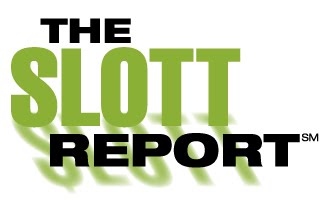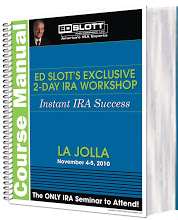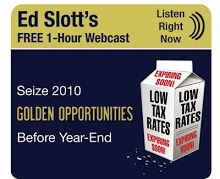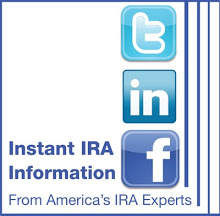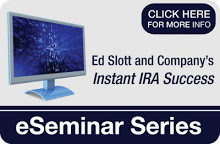Ed Slott wrote a February 24th article in Financial Planning that discusses the perfect time to convert to Roth IRAs (RIGHT NOW!) as long as certain tax traps are avoided.
America's IRA Expert mentions the importance of Beneficiary Forms, talks about partial Roth conversions and underscores the importance of taking a 2010 RMD before converting to a Roth (if you are 70 1/2 or older!).
This is a must-read article when dealing with clients' Roth conversions. CLICK HERE to read the article in its entirety.
In tandem with reading the article, listen to Ed Slott's 1-Hour Webcast, 15 Roth IRA Conversion Traps. CLICK HERE to listen to the 1-Hour Webcast.
Have a great weekend!
Friday, February 26, 2010
Ed Slott in Financial Planning: Not So Fast
Thursday, February 25, 2010
Slott Report Mailbag: February 25th
Here is this week's Slott Report Mailbag. You may not get your mail in the Northeast today or tomorrow, but The Slott Report Mailbag always delivers.
1.
Dear Mr. Slott and Company,
Not surprisingly, there is certainly a fair amount of inconsistency among different sources as to the rules regarding Roths. Can you pay part of the conversion taxes in 2010 and the rest in 2011/2012? Are the income limits lifted for only 2010 or are they lifted indefinitely? (Until further notice, they are lifted beyond 2010).
But here's a vexing question that I can't get consistent answers to! Under what circumstances is an inherited Roth IRA subject to estate taxes if it's left to beneficiaries? Is the Roth considered part of the taxable estate, or does it escape estate tax altogether?
Or does the answer depend on certain circumstances?
What is the best answer, and why does there seem to be a lot of inconsistency about this matter?
Thanks much!
Howard S. Sample
Toledo, Ohio
Answer:
An inherited Roth IRA is always part of your taxable estate. While distributions from the inherited Roth account are income tax-free, they are NOT estate tax-free if the overall estate is subject to estate tax. The federal estate tax has been eliminated, so far, for 2010.
2.
I received a distribution of stock from my IRA. The cost of the stock in the IRA was about $18,000 and the value on the date of distribution was about $13,000. What is the basis to me of the stock distributed? Is it $13,000 or $18,000? Thanks.
Ken
Answer:
Your cost basis of the stock you received as a distribution from the IRA is the fair market value on the date of the distribution. This will be the gross distribution amount in box 1 on the 1099-R you will receive.
3.
My IRA was converted to a Roth in 2009. An RMD is required in 2010. A portion of the 2009 conversion is recharacterized in 2010. What amount is the 2010 RMD based on?
Answer:
The required minimum distribution for 2010 is based on the value as of 12/31/09. Since you are doing a partial recharacterization, you will have to do 2 net income calculations, one for the recharacterization and one to determine the 12/31 value. The formula for this calculation is in IRS Publication 590.
By IRA Technical Consultant Marvin Rotenberg and Jared Trexler
------------------------------------------------------------------------------
Comment, Question, Discussion Topic on your mind? Click on the Blue Comment Link below and leave your thoughts then check back to see what other consumers and advisors think.
*Copyright 2010 Ed Slott and Company, LLC
1.
Dear Mr. Slott and Company,
Not surprisingly, there is certainly a fair amount of inconsistency among different sources as to the rules regarding Roths. Can you pay part of the conversion taxes in 2010 and the rest in 2011/2012? Are the income limits lifted for only 2010 or are they lifted indefinitely? (Until further notice, they are lifted beyond 2010).
But here's a vexing question that I can't get consistent answers to! Under what circumstances is an inherited Roth IRA subject to estate taxes if it's left to beneficiaries? Is the Roth considered part of the taxable estate, or does it escape estate tax altogether?
Or does the answer depend on certain circumstances?
What is the best answer, and why does there seem to be a lot of inconsistency about this matter?
Thanks much!
Howard S. Sample
Toledo, Ohio
Answer:
An inherited Roth IRA is always part of your taxable estate. While distributions from the inherited Roth account are income tax-free, they are NOT estate tax-free if the overall estate is subject to estate tax. The federal estate tax has been eliminated, so far, for 2010.
2.
I received a distribution of stock from my IRA. The cost of the stock in the IRA was about $18,000 and the value on the date of distribution was about $13,000. What is the basis to me of the stock distributed? Is it $13,000 or $18,000? Thanks.
Ken
Answer:
Your cost basis of the stock you received as a distribution from the IRA is the fair market value on the date of the distribution. This will be the gross distribution amount in box 1 on the 1099-R you will receive.
3.
My IRA was converted to a Roth in 2009. An RMD is required in 2010. A portion of the 2009 conversion is recharacterized in 2010. What amount is the 2010 RMD based on?
Answer:
The required minimum distribution for 2010 is based on the value as of 12/31/09. Since you are doing a partial recharacterization, you will have to do 2 net income calculations, one for the recharacterization and one to determine the 12/31 value. The formula for this calculation is in IRS Publication 590.
By IRA Technical Consultant Marvin Rotenberg and Jared Trexler
------------------------------------------------------------------------------
Comment, Question, Discussion Topic on your mind? Click on the Blue Comment Link below and leave your thoughts then check back to see what other consumers and advisors think.
*Copyright 2010 Ed Slott and Company, LLC
Wednesday, February 24, 2010
Be the 1st to Know: Webcast Extended Through March 5th
Our loyal readers at The Slott Report and our Twitter followers are the first to know that, by popular demand, we have extended your time to listen to Ed Slott's 1-Hour Webcast, 15 Roth IRA Conversion Traps, through Friday, March 5th.
http://www.irahelp.com/webcast/registration/
This important, up-to-date information is just the tip of the iceberg. You can get 2 full days of this detailed IRA information, along with the ability to network with other top advisors and ask questions of our on-site IRA Technical Consultants at Ed Slott's 2-Day IRA Workshop, Instant IRA Success, right around the corner on March 19-20 in Orlando, Florida.
IRS Updates Publications
IRS has updated several of its publications that deal with retirement accounts. These publications are a handy reference to anyone whose clients have retirement accounts or to individuals with retirement accounts. But you do have to be careful. There occasionally are mistakes in these publications. However, you can't beat the price. They are free.
Those recently updated include Publication 560, Retirement Plans for Small Business (SEP, SIMPLE, and Qualified Plans), Publication 571, Tax-Sheltered Annuity Plans (403(b) Plans) for Employees of Public Schools and Certain Tax-Exempt Organizations, Publication 575, Pension and Annuity Income (Including Simplified General Rule), and Publication 590, Individual Retirement Arrangements (IRAs).
So where can you find these Publications? They can be found at many IRS offices. You can also order them from IRS by calling (800) TAX-FORM which translated into telephone numbers is (800) 829-3676. You can also find them on the IRS web site, www.irs.gov. On the left hand side of the screen, click on Forms and Publications.
By IRA Technical Consultant Beverly DeVeny and Jared Trexler
------------------------------------------------------------------------------
Comment, Question, Discussion Topic on your mind? Click on the Blue Comment Link below and leave your thoughts then check back to see what other consumers and advisors think.
*Copyright 2010 Ed Slott and Company, LLC
Those recently updated include Publication 560, Retirement Plans for Small Business (SEP, SIMPLE, and Qualified Plans), Publication 571, Tax-Sheltered Annuity Plans (403(b) Plans) for Employees of Public Schools and Certain Tax-Exempt Organizations, Publication 575, Pension and Annuity Income (Including Simplified General Rule), and Publication 590, Individual Retirement Arrangements (IRAs).
So where can you find these Publications? They can be found at many IRS offices. You can also order them from IRS by calling (800) TAX-FORM which translated into telephone numbers is (800) 829-3676. You can also find them on the IRS web site, www.irs.gov. On the left hand side of the screen, click on Forms and Publications.
By IRA Technical Consultant Beverly DeVeny and Jared Trexler
------------------------------------------------------------------------------
Comment, Question, Discussion Topic on your mind? Click on the Blue Comment Link below and leave your thoughts then check back to see what other consumers and advisors think.
*Copyright 2010 Ed Slott and Company, LLC
Tuesday, February 23, 2010
401(k) versus IRA (Part 2 of 2)
Below is Part 2 of the 401(k) versus IRA debate. CLICK HERE to read Part 1.
Assuming you don’t need the money to live on, the worst thing you can do is cash out. You’ll lose the benefit of tax deferred growth as well as a big portion of your nest egg. And if you’re younger than 55 when you take out the money, you’ll pay a 10% early withdrawal penalty on the taxable amount. One exception: if you have appreciated company stock in your plan and you are taking a lump sum distribution, you may want to move it to a taxable account, as you or your heirs could benefit from a special rule that applies to the net unrealized appreciation built up over the years.
If you decide to do a rollover, set up an IRA and instruct your company plan administrator to directly transfer your balance to it. If you take the distribution yourself, your company is generally required to withhold 20% for federal income tax purposes, even if you plan to roll over the entire amount. There could also be state and local income tax withholding, depending upon your domicile. When you take the money yourself from your 401(k) plan to roll over to an IRA, you also face a 60-day deadline to get the job done. If you miss this, the taxable amount will be included in your income for the year of the distribution, plus you’ll be subject to
an early withdrawal penalty if under age 55 and lose any chance for continued tax-deferred growth. You avoid those worries with a direct transfer. Note: generally when you are age 70 ½ or older, your employer will first take out your required distribution for the year and send that to you in a separate check. Your required distribution is not eligible for rollover to an IRA and you cannot satisfy your plan required distribution with a distribution from your IRA.
By IRA Technical Consultant Marvin Rotenberg and Jared Trexler
------------------------------------------------------------------------------
Comment, Question, Discussion Topic on your mind? Click on the Blue Comment Link below and leave your thoughts then check back to see what other consumers and advisors think.
*Copyright 2010 Ed Slott and Company, LLC
Assuming you don’t need the money to live on, the worst thing you can do is cash out. You’ll lose the benefit of tax deferred growth as well as a big portion of your nest egg. And if you’re younger than 55 when you take out the money, you’ll pay a 10% early withdrawal penalty on the taxable amount. One exception: if you have appreciated company stock in your plan and you are taking a lump sum distribution, you may want to move it to a taxable account, as you or your heirs could benefit from a special rule that applies to the net unrealized appreciation built up over the years.
If you decide to do a rollover, set up an IRA and instruct your company plan administrator to directly transfer your balance to it. If you take the distribution yourself, your company is generally required to withhold 20% for federal income tax purposes, even if you plan to roll over the entire amount. There could also be state and local income tax withholding, depending upon your domicile. When you take the money yourself from your 401(k) plan to roll over to an IRA, you also face a 60-day deadline to get the job done. If you miss this, the taxable amount will be included in your income for the year of the distribution, plus you’ll be subject to
an early withdrawal penalty if under age 55 and lose any chance for continued tax-deferred growth. You avoid those worries with a direct transfer. Note: generally when you are age 70 ½ or older, your employer will first take out your required distribution for the year and send that to you in a separate check. Your required distribution is not eligible for rollover to an IRA and you cannot satisfy your plan required distribution with a distribution from your IRA.
By IRA Technical Consultant Marvin Rotenberg and Jared Trexler
------------------------------------------------------------------------------
Comment, Question, Discussion Topic on your mind? Click on the Blue Comment Link below and leave your thoughts then check back to see what other consumers and advisors think.
*Copyright 2010 Ed Slott and Company, LLC
Monday, February 22, 2010
401(k) versus IRA (Part 1 of 2)
IRA Technical Consultant Marvin Rotenberg takes you through the point-counterpart differences when comparing a 401(k) to an IRA in this two-part article.
Part 2 will be featured on The Slott Report tomorrow.
To roll or not to roll? That’s the question facing retirees who need to decide whether to keep their savings in a company retirement plan, move the cash into an IRA, or take the money and run. Each choice has significant implications for taxes, estate planning and investment growth.
Cerulli Associates, a Boston based consulting firm estimates that in 2010, as the baby boomers move into retirement en masse, distributions from company retirement plans will reach approximately $446 billion. In most cases, retirees and job switchers are best off rolling their money to an IRA. The typical company plan offers employees and former employees only a handful of investment choices. But in an IRA you can put money into just about any investment you want, with only a few restrictions. Many individuals feel uncomfortable taking control over their finances. But if you intend to leave your money to your spouse and children, you could lose a large estate planning break; the chance for your heirs to stretch out payments over their lifetimes.
In an IRA, your beneficiaries can take out their required minimum distributions and allow the rest to grow tax-deferred. Most 401(k) and other company plans force heirs to take the assets soon after the account holder dies. Employers generally don’t want to be married to the employee’s family forever. Recent changes to the rules in this area now allow non-spouse beneficiaries to rollover plan assets to both inherited traditional and inherited Roth IRAs, but generally it must be done on a timely basis in order to guarantee the availability of stretch-out payments.
Another advantage the rollover option offers is that you can establish multiple IRAs, each with a different beneficiary, and align the investments towards the particular needs of the beneficiary. For instance, you could choose conservative investments for the IRA that you leave to your spouse, while opting for investments with longer time horizons for the IRA targeted for your children. There may be times when keeping the money in your 401(k) plan may be advantageous. If you’re between age 55 and 59 ½ when you retire or separate from service, decide whether you need the money for living expenses before you make a move. Generally, if you’re age 55 or older when separating from service, you can withdraw the money from the company plan without having to pay an early withdrawal penalty. If you move the money to an IRA, a 10% penalty for early wtihdrawal will linger until you’re 59 ½.
TO BE CONTINUED TUESDAY...
By IRA Technical Consultant Marvin Rotenberg and Jared Trexler
------------------------------------------------------------------------------
Comment, Question, Discussion Topic on your mind? Click on the Blue Comment Link below and leave your thoughts then check back to see what other consumers and advisors think.
*Copyright 2010 Ed Slott and Company, LLC
Part 2 will be featured on The Slott Report tomorrow.
To roll or not to roll? That’s the question facing retirees who need to decide whether to keep their savings in a company retirement plan, move the cash into an IRA, or take the money and run. Each choice has significant implications for taxes, estate planning and investment growth.
Cerulli Associates, a Boston based consulting firm estimates that in 2010, as the baby boomers move into retirement en masse, distributions from company retirement plans will reach approximately $446 billion. In most cases, retirees and job switchers are best off rolling their money to an IRA. The typical company plan offers employees and former employees only a handful of investment choices. But in an IRA you can put money into just about any investment you want, with only a few restrictions. Many individuals feel uncomfortable taking control over their finances. But if you intend to leave your money to your spouse and children, you could lose a large estate planning break; the chance for your heirs to stretch out payments over their lifetimes.
In an IRA, your beneficiaries can take out their required minimum distributions and allow the rest to grow tax-deferred. Most 401(k) and other company plans force heirs to take the assets soon after the account holder dies. Employers generally don’t want to be married to the employee’s family forever. Recent changes to the rules in this area now allow non-spouse beneficiaries to rollover plan assets to both inherited traditional and inherited Roth IRAs, but generally it must be done on a timely basis in order to guarantee the availability of stretch-out payments.
Another advantage the rollover option offers is that you can establish multiple IRAs, each with a different beneficiary, and align the investments towards the particular needs of the beneficiary. For instance, you could choose conservative investments for the IRA that you leave to your spouse, while opting for investments with longer time horizons for the IRA targeted for your children. There may be times when keeping the money in your 401(k) plan may be advantageous. If you’re between age 55 and 59 ½ when you retire or separate from service, decide whether you need the money for living expenses before you make a move. Generally, if you’re age 55 or older when separating from service, you can withdraw the money from the company plan without having to pay an early withdrawal penalty. If you move the money to an IRA, a 10% penalty for early wtihdrawal will linger until you’re 59 ½.
TO BE CONTINUED TUESDAY...
By IRA Technical Consultant Marvin Rotenberg and Jared Trexler
------------------------------------------------------------------------------
Comment, Question, Discussion Topic on your mind? Click on the Blue Comment Link below and leave your thoughts then check back to see what other consumers and advisors think.
*Copyright 2010 Ed Slott and Company, LLC
Ed Slott Speaking Throughout Florida This Week
Ed Slott will be speaking to three different companies in the Sunshine State this week.
Ed will be speaking to Transamerica on February 23rd in Boca Raton.
He will be speaking to Nationwide on February 25th in Tampa.
Ed will be speaking to Raymond James also on the 25th in St. Petersburg.
As always, you can see where Ed is speaking next on his speaking schedule at www.irahelp.com. CLICK HERE to view his speaking schedule.
If you or your business is interested in having Ed speak, please contact Laurin Levine at 516-536-8282.
Ed will be speaking to Transamerica on February 23rd in Boca Raton.
He will be speaking to Nationwide on February 25th in Tampa.
Ed will be speaking to Raymond James also on the 25th in St. Petersburg.
As always, you can see where Ed is speaking next on his speaking schedule at www.irahelp.com. CLICK HERE to view his speaking schedule.
If you or your business is interested in having Ed speak, please contact Laurin Levine at 516-536-8282.
Friday, February 19, 2010
Can’t Make a Roth Contribution - Think Again
It is 2010. In China, it is the year of the tiger. In the US, it is the year of the Roth conversion. Everyone with an IRA can do a Roth conversion this year and many plan participants can also do a conversion. The income limits and tax filing restrictions are permanently repealed. However, the income limits for making a Roth contribution remain in place. The ability to make a Roth contribution phases out for individuals married/filing jointly between $167,000 and $177,000. For a single individual the range is $105,000 - $120,000 and if you are married/filing separate the range is $0 - $10,000.
But all is not lost. Any individual with earned income can make an IRA contribution - and then, the very next day if you want to, convert that contribution to a Roth IRA.
Generally, that IRA contribution will be after tax. But the conversion to the Roth IRA will not be income tax free if the account owner has other IRA accounts. IRS Form 8606 must be used to report an after-tax contribution and it is used again whenever there is any distribution from any IRA, including SEP and SIMPLE IRAs, of the account owner. You cannot convert just the after-tax amount, even if it is in a separate IRA.
The distribution or the conversion will be subject to the pro-rata rule. For a 2010 distribution you take the 2010 year end balance in all IRAs and divide that into the total after-tax amount in all IRAs. The resulting percentage is used to determine the amount of the distribution that will not be taxable. (It’s really a little more complicated than that.) You can find Form 8606 on the IRS website at www.irs.gov. On the left hand side of the screen, click on Forms and Publications.
By IRA Technical Consultant Beverly DeVeny and Jared Trexler
------------------------------------------------------------------------------
Comment, Question, Discussion Topic on your mind? Click on the Blue Comment Link below and leave your thoughts then check back to see what other consumers and advisors think.
*Copyright 2010 Ed Slott and Company, LLC
But all is not lost. Any individual with earned income can make an IRA contribution - and then, the very next day if you want to, convert that contribution to a Roth IRA.
Generally, that IRA contribution will be after tax. But the conversion to the Roth IRA will not be income tax free if the account owner has other IRA accounts. IRS Form 8606 must be used to report an after-tax contribution and it is used again whenever there is any distribution from any IRA, including SEP and SIMPLE IRAs, of the account owner. You cannot convert just the after-tax amount, even if it is in a separate IRA.
The distribution or the conversion will be subject to the pro-rata rule. For a 2010 distribution you take the 2010 year end balance in all IRAs and divide that into the total after-tax amount in all IRAs. The resulting percentage is used to determine the amount of the distribution that will not be taxable. (It’s really a little more complicated than that.) You can find Form 8606 on the IRS website at www.irs.gov. On the left hand side of the screen, click on Forms and Publications.
By IRA Technical Consultant Beverly DeVeny and Jared Trexler
------------------------------------------------------------------------------
Comment, Question, Discussion Topic on your mind? Click on the Blue Comment Link below and leave your thoughts then check back to see what other consumers and advisors think.
*Copyright 2010 Ed Slott and Company, LLC
Slott Report Mailbag: February 18th
This is the February 18th edition of The Slott Report Mailbag.
1.
Mr. Slott and Company,
I appreciate you and your staff identifying the potential impact of Roth conversions on Medicare premiums. My question regards the impact of normal (not subject to income tax) Roth withdrawals on Medicare premiums. I understand that MAGI for determining the amount of these premiums is adjusted to include non-taxable income such as interest on Municipal bonds. Is Medicare MAGI also adjusted to include normal Roth withdrawals?
Thanks,
Richard Moore
Answer:
This is both an income tax and Medicare issue and you should contact your tax preparer for the answer. Thank you for pointing out the potential impact of Roth conversions on Medicare premiums -- it is something your financial team should know about.
2.
Dear Mr. Slott and Company,
I have a traditional IRA with approximately $90,000 in it invested in an annuity and I am still in the surrender period.
I would like to take my 10% penalty free withdrawal and convert it to a Roth. The annuity product that I am going to use as my new Roth account pays a premium bonus.
My question is, what am I going to be required to report to the IRS as income on the conversion amount? Will it be the initial withdrawal and deposit of $9,000 or will it be the amount after the 11% bonus of $990 for a total of $9990?
Thanks,
Richard Woychowski
Answer:
The amount that is reported to the IRS is the amount that is on form 1099-R. This should be the fair market value of the amount that leaves the traditional IRA. We can only answer questions in the context of the IRA rules and cannot address the annuity issues. Please consult your financial advisor and/or the annuity company for guidance in that area.
3.
I am 69 years old, retired since 2009. I have $600,000 in a 401(k) plan which I wish to roll over into an IRA. $500,000 is before tax dollars and $100,000 is after-tax dollars. The plan administrator says that I can roll over the before tax dollars into a traditional IRA and the after-tax dollars into a Roth IRA. Is this correct? I already have an existing traditional IRA and a Roth IRA. The many experts I have consulted have given conflicting answers.
Thank you for your help.
Ed Martin
Answer:
Recent IRS guidance is at odds with the tax code and that is why you are receiving conflicting answers. Stay tuned.
By IRA Technical Consultant Marvin Rotenberg and Jared Trexler
------------------------------------------------------------------------------
Comment, Question, Discussion Topic on your mind? Click on the Blue Comment Link below and leave your thoughts then check back to see what other consumers and advisors think.
*Copyright 2010 Ed Slott and Company, LLC
1.
Mr. Slott and Company,
I appreciate you and your staff identifying the potential impact of Roth conversions on Medicare premiums. My question regards the impact of normal (not subject to income tax) Roth withdrawals on Medicare premiums. I understand that MAGI for determining the amount of these premiums is adjusted to include non-taxable income such as interest on Municipal bonds. Is Medicare MAGI also adjusted to include normal Roth withdrawals?
Thanks,
Richard Moore
Answer:
This is both an income tax and Medicare issue and you should contact your tax preparer for the answer. Thank you for pointing out the potential impact of Roth conversions on Medicare premiums -- it is something your financial team should know about.
2.
Dear Mr. Slott and Company,
I have a traditional IRA with approximately $90,000 in it invested in an annuity and I am still in the surrender period.
I would like to take my 10% penalty free withdrawal and convert it to a Roth. The annuity product that I am going to use as my new Roth account pays a premium bonus.
My question is, what am I going to be required to report to the IRS as income on the conversion amount? Will it be the initial withdrawal and deposit of $9,000 or will it be the amount after the 11% bonus of $990 for a total of $9990?
Thanks,
Richard Woychowski
Answer:
The amount that is reported to the IRS is the amount that is on form 1099-R. This should be the fair market value of the amount that leaves the traditional IRA. We can only answer questions in the context of the IRA rules and cannot address the annuity issues. Please consult your financial advisor and/or the annuity company for guidance in that area.
3.
I am 69 years old, retired since 2009. I have $600,000 in a 401(k) plan which I wish to roll over into an IRA. $500,000 is before tax dollars and $100,000 is after-tax dollars. The plan administrator says that I can roll over the before tax dollars into a traditional IRA and the after-tax dollars into a Roth IRA. Is this correct? I already have an existing traditional IRA and a Roth IRA. The many experts I have consulted have given conflicting answers.
Thank you for your help.
Ed Martin
Answer:
Recent IRS guidance is at odds with the tax code and that is why you are receiving conflicting answers. Stay tuned.
By IRA Technical Consultant Marvin Rotenberg and Jared Trexler
------------------------------------------------------------------------------
Comment, Question, Discussion Topic on your mind? Click on the Blue Comment Link below and leave your thoughts then check back to see what other consumers and advisors think.
*Copyright 2010 Ed Slott and Company, LLC
Wednesday, February 17, 2010
Recommend Your Advisor
In a gray box in the middle of the homepage, consumers can recommend that their financial advisor train with Ed Slott and Company.
Just click on the box and fill out your first and last name then all of your advisor's contact information so we can send him or her the latest details on all of our workshops, webcasts and membership groups.
CLICK HERE to recommend your advisor.
Just click on the box and fill out your first and last name then all of your advisor's contact information so we can send him or her the latest details on all of our workshops, webcasts and membership groups.
CLICK HERE to recommend your advisor.
Tuesday, February 16, 2010
Retirement Fears: Federal Estate Tax Goes Away in 2010
Nothing is certain except death and taxes.
That line has taken on a new meaning in 2010 for federal estate tax. The Economic Growth and Tax Relief Reconciliation Act resulted in the total elimination of the federal estate tax in 2010.
However, it will be back in 2011, and your financial advisor must know the particulars of the 2010 elimination and 2011 return.
This installment of Retirement Fears points out the information you -- and more importantly -- YOUR FINANCIAL ADVISOR must know when dealing with this issue.
That line has taken on a new meaning in 2010 for federal estate tax. The Economic Growth and Tax Relief Reconciliation Act resulted in the total elimination of the federal estate tax in 2010.
However, it will be back in 2011, and your financial advisor must know the particulars of the 2010 elimination and 2011 return.
This installment of Retirement Fears points out the information you -- and more importantly -- YOUR FINANCIAL ADVISOR must know when dealing with this issue.
Monday, February 15, 2010
Could a Roth IRA Be Right?
The San Francisco Chronicle's Kathleen Pender wrote an article detailing the decision many consumers will be asking themselves (and their financial advisors) in 2010:
Could a Roth IRA Be Right?
Ed Slott chimed in by stating, "Once you take the tax hit, you will never have to withdrawal in your lifetime and it can just build (tax-free for your heirs)."
CLICK HERE to read the article in its entirety.
Could a Roth IRA Be Right?
Ed Slott chimed in by stating, "Once you take the tax hit, you will never have to withdrawal in your lifetime and it can just build (tax-free for your heirs)."
CLICK HERE to read the article in its entirety.
Saturday, February 13, 2010
Ed Slott's FREE Webcast: A Snapshot of Orlando
If you want to experience a snapshot of the detailed, business-building information you will learn at Ed Slott's 2-Day IRA Workshop, Instant IRA Success, in Orlando on March 19-20, take an hour of of your workday to listen to the 1-Hour Webcast, Roth IRA Conversion Traps.
Click on the link to the left or go to www.irahelp.com to register, listen and learn 15 invaluable points of emphasis when working with your clients on Roth Conversion planning.
Click on the link to the left or go to www.irahelp.com to register, listen and learn 15 invaluable points of emphasis when working with your clients on Roth Conversion planning.
Thursday, February 11, 2010
Slott Report Mailbag: February 11th
Here is this week's Slott Report Mailbag.
1.
I am about to retire and expect to convert regular IRA money to Roth each year. I will determine the amount based on what my resulting tax bracket will be including the possibility of additional Medicare premiums.
My question has to do with the 5-year rule on Roth withdrawals.
Is it 5 years from the original (first) Roth is established or does the clock start each year for that year's conversion?
If so, is it necessary or recommended that separate accounts be established for each conversion until the 5-year period is up at which time that year's account can be rolled into a main Roth account?
Thanks,
Jim Taylor
Answer:
The five-year period starts with the establishment of your first Roth IRA and covers all future Roth IRAs you may establish. In order words, it only runs once. The five-year rule for each conversion only applies to individuals under the age of 59 1/2 which I assume you are not since you are retiring soon.
It is not necessary to establish separate accounts for each Roth IRA conversion. If however you think there is a possibility you might want to recharacterize later (by October 15, at the latest, of the year following conversion) it may be a good idea to have separate accounts. It would easier to do a recharacterization. After the October 15 date passes you can then combine the accounts.
2.
A couple, ages both 68, with substantial wealth have $2,000,000 in traditional IRAs. The IRAs are not needed for current or future income. Income in the future will not be less than current income, so the tax brackets will be about the same. The IRAs will accumulate and be available for the couples children and grandchildren. Question? Should the couple convert the IRAs to Roth IRAs and pay a 39% Federal Tax and a 7% State Tax now or should they leave the money in traditional IRAs and let the beneficiaries pay the tax when both parents die, and place the IRA in Traditional Beneficiary IRAs? What is the break even number of years if they convert now?
Answer:
There is no clear answer to your question. There are numerous factors to consider when thinking about a Roth IRA conversion. The break even point, as you mentioned, income tax rackets, income in subsequent years, income tax rates in future years, and liquidity outside of the IRA to pay the conversion tax, just to mention a few. We generally favor a Roth conversion for a number of reasons. The decision to convert needs to be reviewed for each individual situation and the IRA owner must be comfortable with paying the income tax up front.
3.
My husband will be required to take his first RMD this year as he turned 70. He is still working although he has stopped contributing to his company 401(k). Does he need to count his 401(k) in his distribution if he is still working?
Answer:
If your husband is still working for the company that maintains the 401(k) plan and he is not a five percent owner, or greater, of the company he does not have to take a required minimum distribution at age 70 1/2, if the plan allows. He can wait until he retires and then he must start required minimum distributions by April 1 of the year following his retirement. If he has IRAs, that rule would not apply and he will have to take required minimum distributions commencing at age 70 1/2.
By IRA Technical Consultant Marvin Rotenberg and Jared Trexler
------------------------------------------------------------------------------
Comment, Question, Discussion Topic on your mind? Click on the Blue Comment Link below and leave your thoughts then check back to see what other consumers and advisors think.
*Copyright 2010 Ed Slott and Company, LLC
1.
I am about to retire and expect to convert regular IRA money to Roth each year. I will determine the amount based on what my resulting tax bracket will be including the possibility of additional Medicare premiums.
My question has to do with the 5-year rule on Roth withdrawals.
Is it 5 years from the original (first) Roth is established or does the clock start each year for that year's conversion?
If so, is it necessary or recommended that separate accounts be established for each conversion until the 5-year period is up at which time that year's account can be rolled into a main Roth account?
Thanks,
Jim Taylor
Answer:
The five-year period starts with the establishment of your first Roth IRA and covers all future Roth IRAs you may establish. In order words, it only runs once. The five-year rule for each conversion only applies to individuals under the age of 59 1/2 which I assume you are not since you are retiring soon.
It is not necessary to establish separate accounts for each Roth IRA conversion. If however you think there is a possibility you might want to recharacterize later (by October 15, at the latest, of the year following conversion) it may be a good idea to have separate accounts. It would easier to do a recharacterization. After the October 15 date passes you can then combine the accounts.
2.
A couple, ages both 68, with substantial wealth have $2,000,000 in traditional IRAs. The IRAs are not needed for current or future income. Income in the future will not be less than current income, so the tax brackets will be about the same. The IRAs will accumulate and be available for the couples children and grandchildren. Question? Should the couple convert the IRAs to Roth IRAs and pay a 39% Federal Tax and a 7% State Tax now or should they leave the money in traditional IRAs and let the beneficiaries pay the tax when both parents die, and place the IRA in Traditional Beneficiary IRAs? What is the break even number of years if they convert now?
Answer:
There is no clear answer to your question. There are numerous factors to consider when thinking about a Roth IRA conversion. The break even point, as you mentioned, income tax rackets, income in subsequent years, income tax rates in future years, and liquidity outside of the IRA to pay the conversion tax, just to mention a few. We generally favor a Roth conversion for a number of reasons. The decision to convert needs to be reviewed for each individual situation and the IRA owner must be comfortable with paying the income tax up front.
3.
My husband will be required to take his first RMD this year as he turned 70. He is still working although he has stopped contributing to his company 401(k). Does he need to count his 401(k) in his distribution if he is still working?
Answer:
If your husband is still working for the company that maintains the 401(k) plan and he is not a five percent owner, or greater, of the company he does not have to take a required minimum distribution at age 70 1/2, if the plan allows. He can wait until he retires and then he must start required minimum distributions by April 1 of the year following his retirement. If he has IRAs, that rule would not apply and he will have to take required minimum distributions commencing at age 70 1/2.
By IRA Technical Consultant Marvin Rotenberg and Jared Trexler
------------------------------------------------------------------------------
Comment, Question, Discussion Topic on your mind? Click on the Blue Comment Link below and leave your thoughts then check back to see what other consumers and advisors think.
*Copyright 2010 Ed Slott and Company, LLC
Wednesday, February 10, 2010
"Everything" Clause Creates a Prohibited Transaction
A while ago I read the following excerpt from the American Idol contract:
"I hereby grant the Producer the unconditional right throughout the universe in perpetuity to use, simulate, or portray my name, likeness, voice, singing voice, personality, personal identification or personal experiences, my life story, biographical data, incidents, situations, events which heretofore occurred or hereafter occur..." I thought “Wow, this covers everything.” With technology changing our world ever faster and with companies attempting to cover all the bases, these types of clauses are making their way into our lives.
Even into the IRA world. Last October, an advisor received an Advisory Opinion from the Department of Labor on behalf of one of his clients which ruled against the IRA custodian. The client had an existing account at a brokerage firm and now wanted to open a self-directed IRA account. The IRA agreement contained the following “everything” clause: “All securities and other property now or hereafter held, carried or maintained by us in our possession or control, for any purpose, in or for the benefit of any of your Accounts, now or hereafter opened, including any Account in which you may have an interest, shall be subject to a continuing first lien and first priority perfected security interest in favor of us for the discharge of all indebtedness and your obligations to us, and are to be held by us as security for the payment of any liability or indebtedness of yours to us in any of your accounts.
You authorize us the right to transfer securities and other property so held by us from or to any other of your Accounts held by us, whenever, in our judgment, we consider such transfer necessary for our protection…”
The Department of Labor said this would create a prohibited transaction. The IRA owner is not allowed to extend credit to the IRA and the IRA is not allowed to extend credit to the IRA owner. Oops, I guess their lawyers need to learn a little bit more about IRA law. But you as an advisor or IRA owner also need to check your IRA contracts and make sure they do not have this type of language. The consequence of a prohibited transaction is the loss of the IRA’s tax deferral and the immediate taxation of the IRA balance.
By IRA Technical Consultant Beverly DeVeny and Jared Trexler
------------------------------------------------------------------------------
Comment, Question, Discussion Topic on your mind? Click on the Blue Comment Link below and leave your thoughts then check back to see what other consumers and advisors think.
*Copyright 2010 Ed Slott and Company, LLC
"I hereby grant the Producer the unconditional right throughout the universe in perpetuity to use, simulate, or portray my name, likeness, voice, singing voice, personality, personal identification or personal experiences, my life story, biographical data, incidents, situations, events which heretofore occurred or hereafter occur..." I thought “Wow, this covers everything.” With technology changing our world ever faster and with companies attempting to cover all the bases, these types of clauses are making their way into our lives.
Even into the IRA world. Last October, an advisor received an Advisory Opinion from the Department of Labor on behalf of one of his clients which ruled against the IRA custodian. The client had an existing account at a brokerage firm and now wanted to open a self-directed IRA account. The IRA agreement contained the following “everything” clause: “All securities and other property now or hereafter held, carried or maintained by us in our possession or control, for any purpose, in or for the benefit of any of your Accounts, now or hereafter opened, including any Account in which you may have an interest, shall be subject to a continuing first lien and first priority perfected security interest in favor of us for the discharge of all indebtedness and your obligations to us, and are to be held by us as security for the payment of any liability or indebtedness of yours to us in any of your accounts.
You authorize us the right to transfer securities and other property so held by us from or to any other of your Accounts held by us, whenever, in our judgment, we consider such transfer necessary for our protection…”
The Department of Labor said this would create a prohibited transaction. The IRA owner is not allowed to extend credit to the IRA and the IRA is not allowed to extend credit to the IRA owner. Oops, I guess their lawyers need to learn a little bit more about IRA law. But you as an advisor or IRA owner also need to check your IRA contracts and make sure they do not have this type of language. The consequence of a prohibited transaction is the loss of the IRA’s tax deferral and the immediate taxation of the IRA balance.
By IRA Technical Consultant Beverly DeVeny and Jared Trexler
------------------------------------------------------------------------------
Comment, Question, Discussion Topic on your mind? Click on the Blue Comment Link below and leave your thoughts then check back to see what other consumers and advisors think.
*Copyright 2010 Ed Slott and Company, LLC
Tuesday, February 9, 2010
Ed Slott's 1-Hour Webcast: 15 Roth IRA Conversion Traps
Just a reminder that Ed Slott's FREE 1-Hour Webcast, 15 Roth IRA Conversion Traps, is still available on our website through February 26th!
You can listen at anytime, as many times as you want between NOW and February 26th. Just log on to www.irahelp.com and click on the banner at the top middle of the page or click on the Webcast link along the left side of this page to register.
If you have any questions, please call 215-557-7022.
You can listen at anytime, as many times as you want between NOW and February 26th. Just log on to www.irahelp.com and click on the banner at the top middle of the page or click on the Webcast link along the left side of this page to register.
If you have any questions, please call 215-557-7022.
February IRA Updates
Ed Slott and Company's February IRA Updates have now been e-mailed out to all recipients.
The Monthly IRA Updates are compiled in an enewsletter with a preview of that month's Ed Slott's IRA Advisor newsletter, a Ruling to Remember, Key Focus and Question of the Month.
Also included are invaluable links to product and company information.
To sign in for the FREE monthly enewsletter, enter your e-mail address in the box at the top left of the page or log on to www.irahelp.com and enter it in the box along the right-hand side of the homepage.
If you have any questions, please call 215-557-7022.
The Monthly IRA Updates are compiled in an enewsletter with a preview of that month's Ed Slott's IRA Advisor newsletter, a Ruling to Remember, Key Focus and Question of the Month.
Also included are invaluable links to product and company information.
To sign in for the FREE monthly enewsletter, enter your e-mail address in the box at the top left of the page or log on to www.irahelp.com and enter it in the box along the right-hand side of the homepage.
If you have any questions, please call 215-557-7022.
Monday, February 8, 2010
Your Social Security
Taking a trip down memory lane, here are some interesting facts about Social Security:
In 1935, President Franklin D. Roosevelt introduced the Social Security program (OASDI - Old Age, Survivors and Disability) as part of his New Deal agenda. Several things were promised about the program. The following is a summary of some of those promises and a look at how they actually turned out:
PROMISE #1: Participation in the program would be completely voluntary.
RESULT: Participation is now mandatory for all wage earners.
PROMISE #2: Participants would only have to pay 1% of their annual incomes into the program.
RESULT: Now 7.65%
PROMISE #3: The money contributed by the participants would be put into the independent "Trust Fund" rather than into the general operating fund, and therefor, would only be used to fund the Social Security Retirement Program, and no other government programs.
RESULT: The money was moved to the General Fund and has been spent on other entitlements.
PROMISE #4: Payments to program recipients would never be taxed as income.
RESULT: Up to 85% of your social security annual payment can be taxed.
The metamorphosis of social security from its inception to today may best be described by the words of Thomas Jefferson, who once said: "A government big enough to give you everything you want, is strong enough to take everything you have."
By IRA Technical Consultant Marvin Rotenberg and Jared Trexler
------------------------------------------------------------------------------
Comment, Question, Discussion Topic on your mind? Click on the Blue Comment Link below and leave your thoughts then check back to see what other consumers and advisors think.
*Copyright 2010 Ed Slott and Company, LLC
In 1935, President Franklin D. Roosevelt introduced the Social Security program (OASDI - Old Age, Survivors and Disability) as part of his New Deal agenda. Several things were promised about the program. The following is a summary of some of those promises and a look at how they actually turned out:
PROMISE #1: Participation in the program would be completely voluntary.
RESULT: Participation is now mandatory for all wage earners.
PROMISE #2: Participants would only have to pay 1% of their annual incomes into the program.
RESULT: Now 7.65%
PROMISE #3: The money contributed by the participants would be put into the independent "Trust Fund" rather than into the general operating fund, and therefor, would only be used to fund the Social Security Retirement Program, and no other government programs.
RESULT: The money was moved to the General Fund and has been spent on other entitlements.
PROMISE #4: Payments to program recipients would never be taxed as income.
RESULT: Up to 85% of your social security annual payment can be taxed.
The metamorphosis of social security from its inception to today may best be described by the words of Thomas Jefferson, who once said: "A government big enough to give you everything you want, is strong enough to take everything you have."
By IRA Technical Consultant Marvin Rotenberg and Jared Trexler
------------------------------------------------------------------------------
Comment, Question, Discussion Topic on your mind? Click on the Blue Comment Link below and leave your thoughts then check back to see what other consumers and advisors think.
*Copyright 2010 Ed Slott and Company, LLC
Friday, February 5, 2010
NY Times Blog: Ed Slott on Roth IRAs (Part 8)
The work week winds down with an avalanche of questions coming into The New York Times "Bucks" blog dealing with Roth Conversions.
Ed Slott, America's IRA Expert, answered 3 consumer questions in Part 8 of the ongoing series.
CLICK HERE to read the entire Q&A in The New York Times.
Ed Slott, America's IRA Expert, answered 3 consumer questions in Part 8 of the ongoing series.
CLICK HERE to read the entire Q&A in The New York Times.
NY Times Blog: Ed Slott on Roth IRAs (Part 7)
Ed Slott again stopped by to answer consumer questions in the "Bucks" section of The New York Times. America's IRA Expert answered three consumer questions on Roth conversions, with one looking into the current tax season.
CLICK HERE to read the Q&A in The New York Times.
CLICK HERE to read the Q&A in The New York Times.
Thursday, February 4, 2010
Slott Report Mailbag: February 4th
Here is another edition of The Slott Report Mailbag with three consumer questions and our answers.
1.
I was 70 1/2 in February 2009. I didn't take a RMD in 2009. I must take my first RMD this year. What age do I base the amount on, my age now or my 2009 age? Thanks.
Answer:
You first required distribution will be in 2010 and you will have to take it by 12/31/10. You were age 70 1/2 last year, but there were no required minimum distributions for 2009. You will use your age 72 for this year since you are calculating your 2010 distribution (that will be your attained age on 12/31/10). The life expectancy factor for age 72 is 25.6. The account balance you will use is the balance on 12/31/09.
2.
Can federal employees who contribute to a TSP, Thrift Savings Program, have part or all of their TSP contributions converted to a Roth IRA, and if so, what is the best way to do it in terms of the taxes that would be owed?
Sincerely,
Pamela S. Perry
Temple, Texas
Answer:
Yes, TSP's are generally eligible for a Roth IRA conversion. You need to check the provisions in the plan document to determine if you are eligible to take a distribution.
For conversions in 2010 you have the option to include the conversion amount in your 2010 tax return or if you chose not to include it in 2010 then you must report 1/2 on your 2011 return and 1/2 on your 2012 return. Factors to consider to determine when you should pay the tax due would include; what you think your income will be in 2010, 2011 and 2012 and what you think the income tax rates will be; higher, lower or the same. You also need to consider where the funds will come from to pay the tax and when they will be available. You do not want to take funds from the Roth IRA to pay the conversion tax if you can avoid it.
3.
Ed and Company,
I recall that while working full time (before my retirement over 20 years ago), my wife and I had made several successive non-deductible IRA contributions - dutifully reported with my annual 1040s on Form 8606.
Now that I am considering a Roth IRA conversion, the IRS says it has kept no records of the returns I filed that long ago and its up to me to come up with the numbers on those old 8606s. I don't have returns going back beyond about 12 years ago. Any ideas or suggestions?
Answer:
Unfortunately, you don't have a lot of options. If you have old account statements showing the non-deductible contribution perhaps it might be acceptable to the IRS. You can also try calling the IRA custodian to see if they can provide you will any information on deposits to the account or 5498s issued. If you use a CPA to prepare your tax return, maybe he or she has a copy of your last 8606 filed. Good luck.
By IRA Technical Consultant Marvin Rotenberg and Jared Trexler
------------------------------------------------------------------------------
Comment, Question, Discussion Topic on your mind? Click on the Blue Comment Link below and leave your thoughts then check back to see what other consumers and advisors think.
*Copyright 2010 Ed Slott and Company, LLC
1.
I was 70 1/2 in February 2009. I didn't take a RMD in 2009. I must take my first RMD this year. What age do I base the amount on, my age now or my 2009 age? Thanks.
Answer:
You first required distribution will be in 2010 and you will have to take it by 12/31/10. You were age 70 1/2 last year, but there were no required minimum distributions for 2009. You will use your age 72 for this year since you are calculating your 2010 distribution (that will be your attained age on 12/31/10). The life expectancy factor for age 72 is 25.6. The account balance you will use is the balance on 12/31/09.
2.
Can federal employees who contribute to a TSP, Thrift Savings Program, have part or all of their TSP contributions converted to a Roth IRA, and if so, what is the best way to do it in terms of the taxes that would be owed?
Sincerely,
Pamela S. Perry
Temple, Texas
Answer:
Yes, TSP's are generally eligible for a Roth IRA conversion. You need to check the provisions in the plan document to determine if you are eligible to take a distribution.
For conversions in 2010 you have the option to include the conversion amount in your 2010 tax return or if you chose not to include it in 2010 then you must report 1/2 on your 2011 return and 1/2 on your 2012 return. Factors to consider to determine when you should pay the tax due would include; what you think your income will be in 2010, 2011 and 2012 and what you think the income tax rates will be; higher, lower or the same. You also need to consider where the funds will come from to pay the tax and when they will be available. You do not want to take funds from the Roth IRA to pay the conversion tax if you can avoid it.
3.
Ed and Company,
I recall that while working full time (before my retirement over 20 years ago), my wife and I had made several successive non-deductible IRA contributions - dutifully reported with my annual 1040s on Form 8606.
Now that I am considering a Roth IRA conversion, the IRS says it has kept no records of the returns I filed that long ago and its up to me to come up with the numbers on those old 8606s. I don't have returns going back beyond about 12 years ago. Any ideas or suggestions?
Answer:
Unfortunately, you don't have a lot of options. If you have old account statements showing the non-deductible contribution perhaps it might be acceptable to the IRS. You can also try calling the IRA custodian to see if they can provide you will any information on deposits to the account or 5498s issued. If you use a CPA to prepare your tax return, maybe he or she has a copy of your last 8606 filed. Good luck.
By IRA Technical Consultant Marvin Rotenberg and Jared Trexler
------------------------------------------------------------------------------
Comment, Question, Discussion Topic on your mind? Click on the Blue Comment Link below and leave your thoughts then check back to see what other consumers and advisors think.
*Copyright 2010 Ed Slott and Company, LLC
Wednesday, February 3, 2010
2010 Roth Conversions: Can a Tax Return be Amended to Change the Tax Reporting Election?
Here's the question we have been getting. Suppose I convert in 2010 and decide to spread the income over 2011 and 2012. I file my tax return for 2010. Later on I decide I would have been better off paying the tax all in 2010. Can I go back and amend my return? Sometimes the question comes in the reverse. I paid all the tax, now I want to change my mind and spread it over two years. Can I do that?
Congress was ahead of you here. (insert sarcasm at any time) They figured that some taxpayers just wouldn't be able to make up their minds. Or maybe they can't make a commitment. Or, maybe they want to arbitrage the tax rates.
So, the law says that once your tax filing deadline, plus extensions, has passed, you cannot change your mind on how you want to pay the taxes on a 2010 conversion and amend your return. As of October 15, 2011, whatever is on your tax return is irrevocable. (Actually, it is October 17th because the 15th is a Saturday).
That should be a long enough time frame for taxpayers. By that time you should know what the tax rates are for 2011 although 2012 may still be a mystery.
By IRA Technical Consultant Beverly DeVeny and Jared Trexler
------------------------------------------------------------------------------
Comment, Question, Discussion Topic on your mind? Click on the Blue Comment Link below and leave your thoughts then check back to see what other consumers and advisors think.
*Copyright 2010 Ed Slott and Company, LLC
Congress was ahead of you here. (insert sarcasm at any time) They figured that some taxpayers just wouldn't be able to make up their minds. Or maybe they can't make a commitment. Or, maybe they want to arbitrage the tax rates.
So, the law says that once your tax filing deadline, plus extensions, has passed, you cannot change your mind on how you want to pay the taxes on a 2010 conversion and amend your return. As of October 15, 2011, whatever is on your tax return is irrevocable. (Actually, it is October 17th because the 15th is a Saturday).
That should be a long enough time frame for taxpayers. By that time you should know what the tax rates are for 2011 although 2012 may still be a mystery.
By IRA Technical Consultant Beverly DeVeny and Jared Trexler
------------------------------------------------------------------------------
Comment, Question, Discussion Topic on your mind? Click on the Blue Comment Link below and leave your thoughts then check back to see what other consumers and advisors think.
*Copyright 2010 Ed Slott and Company, LLC
Tuesday, February 2, 2010
Ed Slott's FREE 1-Hour Webcast is NOW LIVE
Ed Slott's FREE 1-Hour Webcast, 15 Roth IRA Conversion Traps, is NOW available at www.irahelp.com.
The hour-long webcast is jam-packed with information on Roth conversion traps most advisors don't know to ask about.
You can listen to the webcast at any time between NOW and February 26th.
If you have any questions, please give us a call at 215-557-7022.
The hour-long webcast is jam-packed with information on Roth conversion traps most advisors don't know to ask about.
You can listen to the webcast at any time between NOW and February 26th.
If you have any questions, please give us a call at 215-557-7022.
Retirement Fears: A New Retirement
Today, Ed Slott and Company plays part financial authority, part educated psychologist.
The gradual track to retirement is full of many life-changing decisions, many of which are personal in nature but have a profound effect on financial stability.
This installment of Retirement Fears touches on how a competent, educated...and caring financial advisor can walk you through those important personal decisions and how they will have an ultimate bearing on an individual's financial flexibility during the golden years.
CLICK HERE to read the Retirement Fears article.
The gradual track to retirement is full of many life-changing decisions, many of which are personal in nature but have a profound effect on financial stability.
This installment of Retirement Fears touches on how a competent, educated...and caring financial advisor can walk you through those important personal decisions and how they will have an ultimate bearing on an individual's financial flexibility during the golden years.
CLICK HERE to read the Retirement Fears article.
Monday, February 1, 2010
Investment News: Tax Traps of Non-Deductible IRA conversion
Ed Slott wrote a January 31st article for Investment News that discussed the tax traps of non-deductible IRA conversion.
America's IRA Expert discusses how crucial timing is when it comes to calculating our clients' taxable income for a given year.
CLICK HERE to read Ed's article.
America's IRA Expert discusses how crucial timing is when it comes to calculating our clients' taxable income for a given year.
CLICK HERE to read Ed's article.
Subscribe to:
Posts (Atom)
